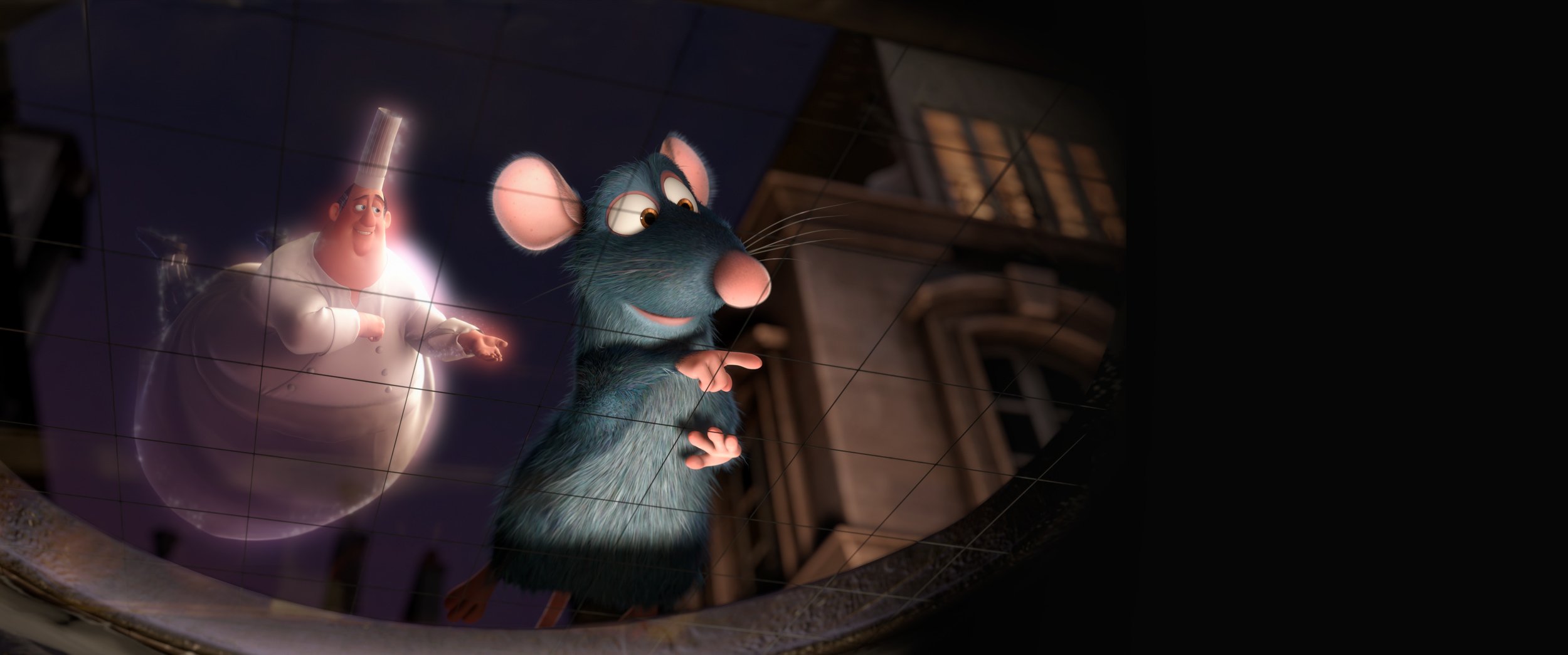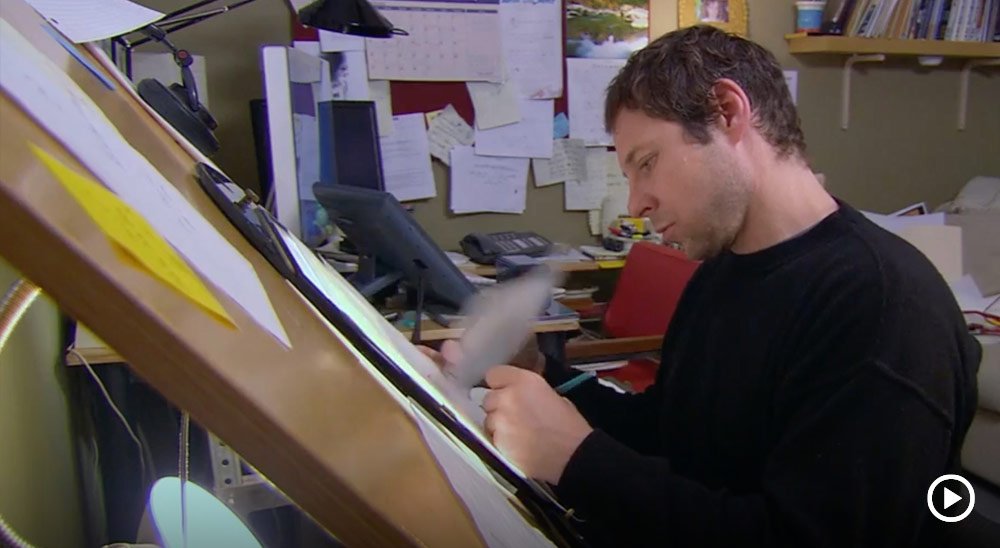
He’s Dying To Become A Chef
A rat named Remy dreams of becoming a great chef despite his family's wishes, and the obvious problem of being a rat in a decidedly rodent-phobic profession. When fate places Remy in the sewers of Paris, he finds himself ideally situated beneath a restaurant made famous by his culinary hero, Auguste Gusteau. Remy's passion for cooking soon sets into motion a hilarious and exciting rat race that turns the world of Paris upside down.
Trailers & Clips
“Side By Side” - Clip
Trailer 1

T H E C H A R A C T E R S
The Artist Rat
"Remy’s dilemma is basically the same as any artist’s. In many countries, certainly this one, art is considered extra, something you do after real work is over. The idea of doing it for a living is widely considered impractical at best. But for our rat Remy, art—experiencing it, trying to create it—is one of the biggest reasons there is to get up in the morning." - Writer/Director Brad Bird.
Linguini
Collete
Remy
Rats are no strangers to rejection, but Remy, a rat who longs to be a great chef, has more than the usual obstacles to overcome. His remarkable sense of smell and genius for combining flavors puts him head and shoulders above most human chefs. However, in the rat world he’s resigned to a life of being the “poison sniffer,” using his unique talent to pick out the safe garbage for his family to eat.
Auguste Gusteau
The late Auguste Gusteau, France’s all-time greatest culinary genius, is the author of Anyone Can Cook, the cookbook that inspires Remy's dream of becoming a chef. Gusteau's Paris restaurant became a landmark on the strength of his imaginative vision and masterful preparation, which simultaneously honored and played with the traditions of French cuisine. Gusteau died mysteriously soon after his restaurant was downgraded from five stars to four (by food critic Anton Ego), but his spirit lives on in his recipes and Remy’s imagination—the great chef is a recurring figure as Remy’s imaginary soul mate and counselor.
Linguini
Linguini, a timid and well-meaning young man, is the new garbage boy at Gusteau’s. After a series of ill-fated jobs, Linguini is desperate to hold onto this one, which he sees as his last hope. A chance encounter with Remy thrusts Linguini into a highly unusual “ghost-cooking” relationship, in which he provides the gangly brawn for Remy’s culinary brains. As Remy’s food attracts more and more attention, the pair is subject to increasingly intense scrutiny. But for Linguini, the opportunity to spend time around his new mentor, Colette, makes all the stress manageable—barely.
Colette
Colette is the toughest chef and the only female in the kitchen at Gusteau’s. Her grit, talent, and intimidating air have brought her far, but years of climbing the ladder in the male-dominated world of haute cuisine have made her wary and self-contained. At first, she is exasperated at being assigned to babysit Linguini as he begins his trial period as a chef. But as time passes, Linguini’s vulnerability and guilelessness begin to win
her over.
Anton Ego
Anton Ego, the most powerful food critic in Paris, can make or break a restaurant with a single review. The sight of his dour, colorless, unsmiling face strikes fear into the heart of even the most complacently successful of culinary celebrities. Chefs have become so afraid of displeasing “The Grim Eater,” as he is commonly known, that no one dares to change a menu without his blessing. Ego has grown accustomed to this power over the years and by now regards it as his due.
Skinner
Skinner, whose modest physical stature belies a domineering, even sadistic personality, is the chef in charge at Gusteau’s. Once the sous-chef to Gusteau himself, Skinner assumed control of the restaurant and business when the great chef died without an heir, and promptly set about exploiting Gusteau’s reputation with an extensive and mercenary line of Gusteau-branded products, from pizzas to frozen burritos. He’s driven the restaurant, once a temple of culinary art, into a profitable but soulless luxury meal machine.
Chefs
Like a band of pirates, many nationalities often comprise the team of line chefs working in France's best restaurants. They hail from all over the world, drawn to the ship-like kitchens of the master chefs to rigorously train under the best. The kitchen can also be compared to a military operation: each chef is assigned a title, station, and specific tasks. The motley characters of Horst, Lalo, and Larousse round out the ranks at Gusteau’s.
Emile
Emile, Remy’s little brother, is a rat’s rat—a little overweight and good-natured, he loves life and all things edible and inedible. He doesn’t always understand the finer points of his brother’s obsession with good food, but he is always ready to support Remy on one of his harebrained errands or cheer him up when he's feeling low.
Django
Django, Remy’s father, is the patriarch of the rat clan. Django expects his oldest son, Remy, to one day take over the responsibilities of leading and providing for the extended rat family, but he is frustrated by his son’s finicky reluctance to eat perfectly good garbage. To Django, it’s clear that “humans=death” and a restaurant kitchen is no place for Remy to be hanging around, not to mention cooking.

T H E W O R L D
Old School
Having broken new ground with their elaborate CG renderings, the Pixar team decided to give Ratatouille an old-school finish. For the end titles, as well as a DVD short, they enlisted hand-drawn animation, filling the halls of Pixar with the unfamiliar sound of rustling paper. According to the animators, the hands-on process was “like going back to your hometown.”
Behind Swinging Doors
Building Paris
The Care And Feeding Of Your Rat
Something New
Gusteau’s
On one side, Gusteau’s hushed, luxurious restaurant is almost like a theater, explained Production Designer Harley Jessup. On the other side is the clattery intensity of the kitchen. “So the doorway into the dining room is almost like a stage proscenium, where waiters come out from backstage to present dishes to the audience of diners,” Jessup noted. “We also thought of the dining room as a palace for food and designed it both to awe the viewer and to make the food and the diners look good.”
Linguini’s Apartment
Brad Bird envisioned Linguini’s apartment as the cheapest in Paris. So the design took an unintended living space, much like an attic or storage space, that had been converted with as many inconveniences as possible. For example, Linguini has to climb up four flights of stairs with his bicycle that couldn't be left on the street for fear of being stolen, the door opens just enough to awkwardly enter, and he has to bend and stretch to maneuver around the furniture—but Linguini has what he needs: an incredible view of Paris to help him dream.
Paris
Going strictly by the storyline, Ratatouille could have taken place almost entirely within the kitchen. But the filmmakers took every opportunity to move the action out into the photogenic streets of Paris. While the City of Light would provide eye candy for the audience, it would also serve the story, a constant reminder of the rarefied human world that made Remy’s dream so daunting.
Sewers
Production Designer Harley Jessup had long read about Paris's famous sewers, but when the Pixar team went to France for a firsthand viewing, they weren’t quite as evocative and romantic as envisioned. “So, because it’s entertainment, because we wanted to do something that was bigger than life and caricatured, we felt the audience would respond to us taking some artistic license and creating a grander, more Phantom of the Opera, Les Miserables-type of sewer.“












































































